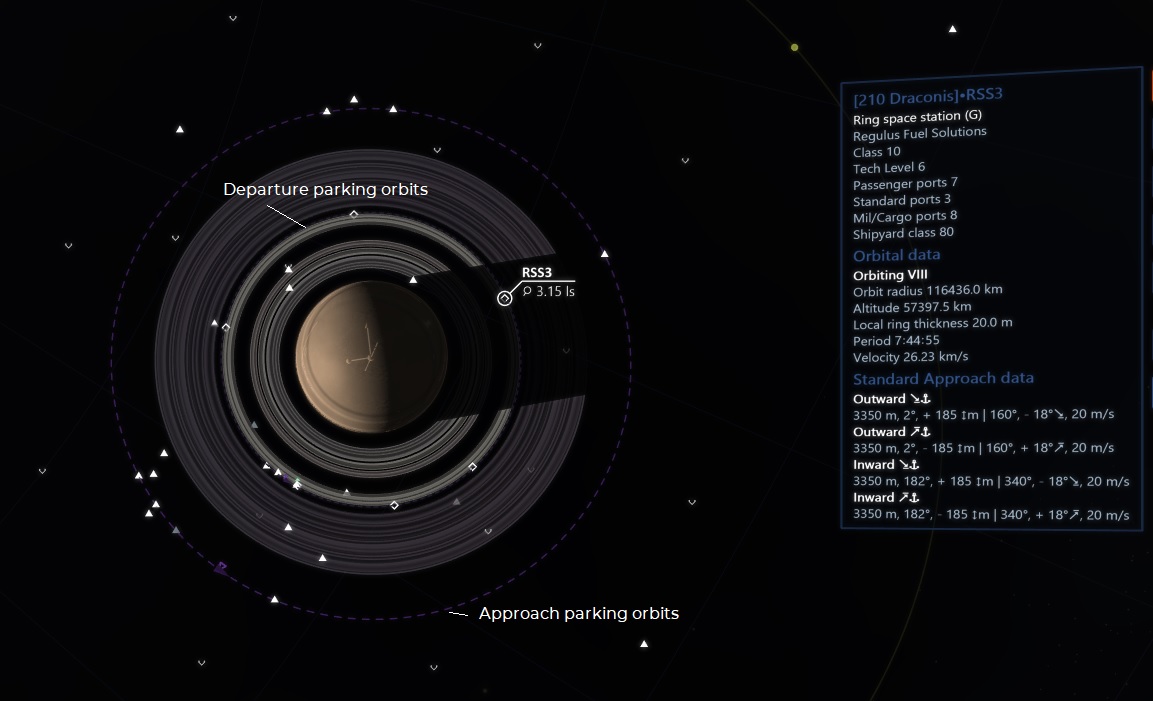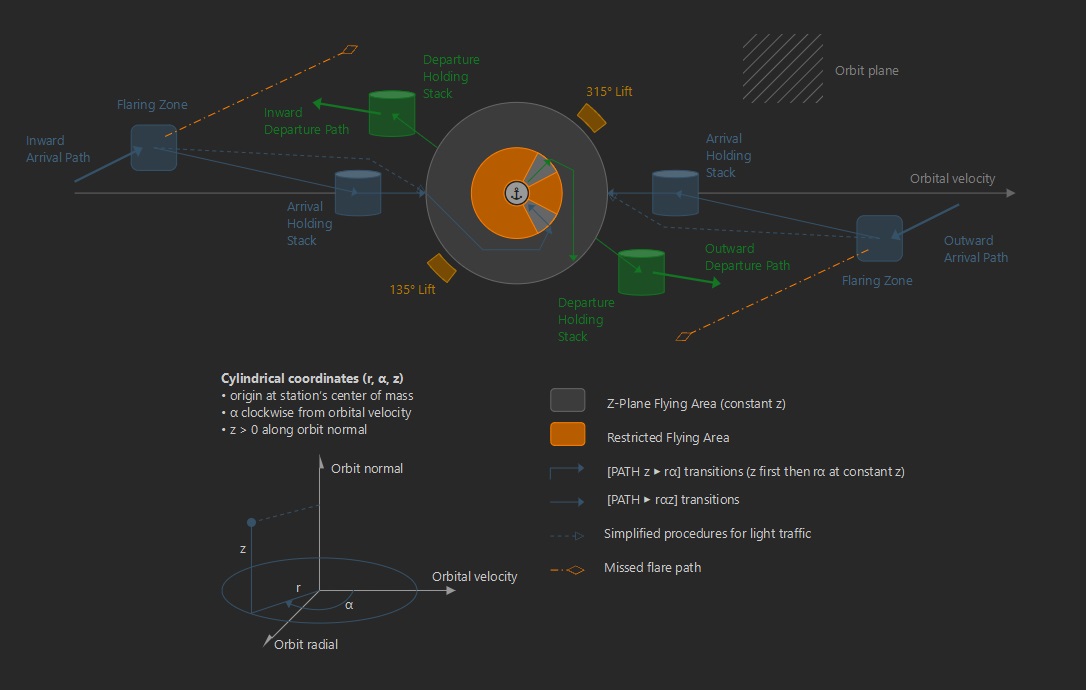Contents
Galactic Navigation Organization
As a result the Galactic Navigation Organization is one of the very few independent galactic institutions in existence, and accepted by all factions. Its role is to edict common rules for safe space operations.
Primary Navigation Rules
Controlled Orbspaces
- The orbital space – orbspace – within 100 km of an orbital facility is restricted.
- All flights within, inbound and outbound of a restricted orbspace require an OTC clearance.
Within a restricted orbspace:
- Thermonuclear propulsion is prohibited.
- Thermonuclear power generation is prohibited, (but might be tolerated for low power regimes within a 75 km radius (typically for reactor ramp-ups and ramp-downs).
- Relative velocities must obey the facility’s published approach profiles.
In effect this restricts all flights to low-ΔV paths, with limited acceleration solely provided by the maneuvering thrusters. Most approach flares and departure burns require less than 30 m/s of ΔV.
Mandatory comms and signaling
- All vessels must be fitted with radio transceivers able to communicate on the GUARD, OTC and BEACON channel sets.
- All vessels must broadcast their state vector and regulation navigation data every 20 s on the BEACON channel (cf beacon protocol)

Standard Procedures
Direction and Slope
Procedures are oriented with respect to the gravity well:
- Inward procedures descend into the gravity well and are associated with retrograde maneuvers.
- Outward procedures climb the gravity well are rely on initial prograde burns.
As a result outward departures and inward approaches are the most common procedures. The situation corresponds to an inner ring of orbital facilities and ships coming from and departing to higher radii.
Arriving ships wait for their transfer towards the stations on a group of outer parking orbits. The significant orbital velocity difference limits the synchronization wait.
Departing ones wait for their first planned high-thrust transfer maneuver on inner orbits near the station. These are generally set by a low-thrust circularization maneuver upon reaching the apoapsis following the departure burn.
Inbound and outbound paths exhibit a non-zero normal component :
- Ascending procedures exhibit a positive vertical velocity (along the orbit normal).
- Descending procedures exhibit a negative vertical velocity (along the orbit normal).
This is particularly important at ring stations and with docking ports located above and below the planetary rings (see the Approach § below).
Non-Precision Departure
When executing a “non-precision” departure, a vessel performs its departure burn from the station as soon as cleared by OTC, without any time constraint. (In effect that means that this maneuver cannot be part of a detailed flight plan, hence the “non-precision” label).
Regardless of the expected following deep-space operations, a subsequent circularization maneuver at the following apoapsis (periapsis in the inward direction) is advised to avoid any risk of orbspace infringement.
Non-precision departure flow:
- Configure the ship for undocking.
- Request the departure to OTC.
- After receiving the undocking clearance, follow OTC’s instructions to reach the facility’s departure stack.
- Execute the departure burn as soon as cleared.
- [Circularize at the following apoapsis / periapsis.]
Please refer to the Flight Sequence ‣ Non-Precision Departure checklist for detailed instructions.
Precision Departure
In the case of a “precision” departure, the departure burn is precisely timed and part of an overall flight plan. OTC will then adjust the undocking so that the vessel can reach the departure stack in time for the maneuver.
Precision departure flow:
- Pick the desired departure date and time and submit the request to OTC. If granting the clearance, OTC will indicate the planned undocking time.
- Plan the flight starting from the corresponding departure burn.
- Configure the ship for undocking when approaching the planned undocking time.
- After receiving the undocking clearance, follow OTC’s instructions to reach the facility’s departure stack.
- Once in place OTC will grant the departure clearance in advance of the planned burn.
- Start executing the flight as planned.
Please refer to the Flight Sequence ‣ Precision Departure checklist for detailed instructions.
Approach
As mentioned above main engine maneuvers are not allowed in the vicinity of stations for obvious safety reasons. The rendez-vous maneuver is thus shifted away from the destination (> 200 km). The exit trajectory is a “glide” path that leads to the station’s final flaring zone. Fusion reactors must be shut down prior to entering the restricted orbspace. The final braking maneuver is performed using the maneuvering thrusters (ΔV < 30 km/s).

Approach flow:
- Request approach vectors from OTC for a selected destination station and type of docking port.
- Plan the approach path accordingly (see the Flight Planning ‣ Approach Planning checklist).
- Submit the solution to OTC. If granted the clearance proceed to step 4, else retry step 2 with a different arrival time.
- Execute the transfer injection maneuver towards the stations’ orbit.
- Execute the rendez-vous to the glide path.
- Shut the reactor down.
- Execute the final flare using the maneuvering thrusters.
Note: it is possible to plan an approach in advance of the flight. In that case:
- The approach parameters must be picked from the station’s published database.
- Particular attention should be paid at ringed planets for the selection of the approach’s slope. Notably it should be ensured that the desired docking port is located on the correct orbital half-plane.
- The approach must still be submitted to OTC for approval, and may be rejected.
Orbspace Partitioning around Stations
The inner orbital space around stations is strictly controlled and all translations require a prior clearance from OTC.
In order to maintain a safe separation between the transiting vessels, the orbspace is further partitioned into logical zones; their effective layout depends on the station and current traffic.

Please check the APP Mode description for information on the related avionics.